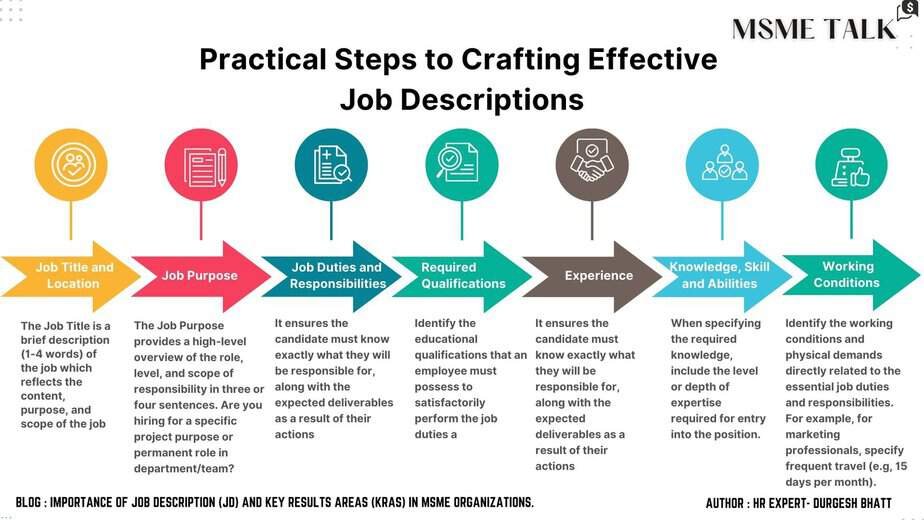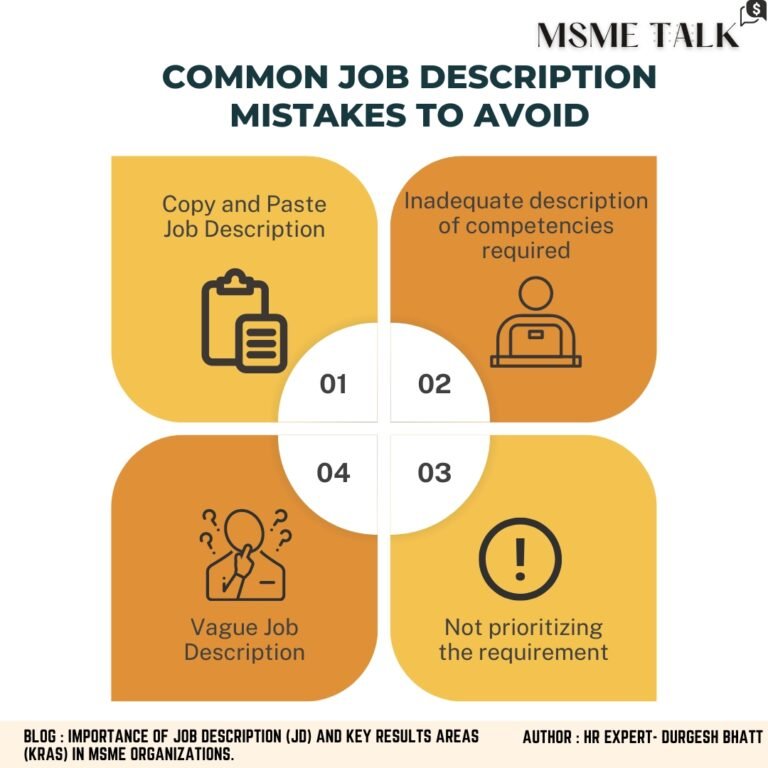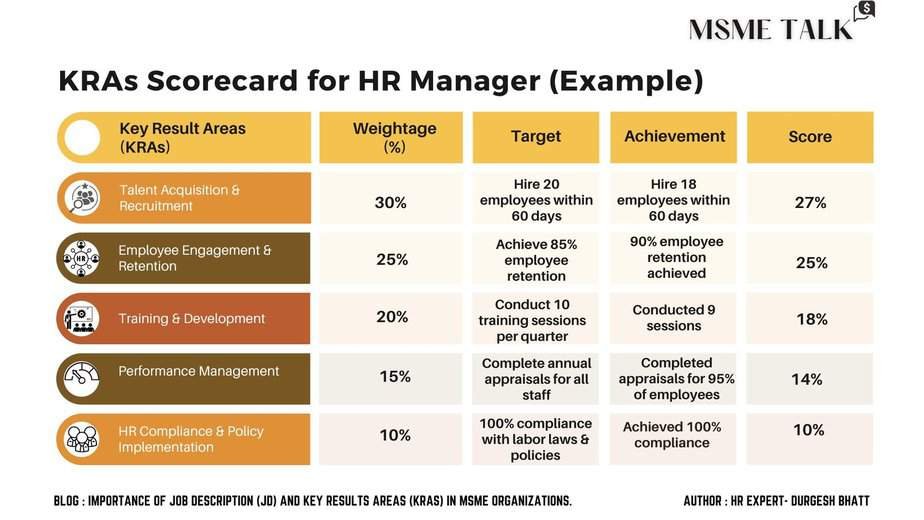Contents
ToggleImportance of Job Description (JD) and Key Results Areas (KRAs) in MSME organizations
In a rapidly changing business landscape, MSMEs face unique challenges in managing their workforce, and without clear JDs and KRAs, even the most talented employees can struggle to grasp their roles and how they contribute to the company’s success. In this blog, we highlight the crucial role of Job Descriptions (JDs) and Key Result Areas (KRAs).Plus, we’ll provide practical steps for crafting effective JDs and point out common pitfalls to avoid.
Importance of Job Description (JD) and Key Results Areas (KRAs) in MSME organizations by Durgesh Bhatt, HR Expert, Beaconz HR
Key Objectives of JD and KRAs
- Enhance Role Clarity: The objective is to accurately explain the requirements and responsibilities of a position within an organization.
- Improve Performance Management: As employees have defined JD and KRAs, employer can measure their performance effectively and identify the areas of improvement.
- Aligning individual goals with business goals: When employees knows how their contributions are aligning to company’s goal, the outcome will be better as they are motivated and engaged.
- Increase Accountability: When roles and expected outcomes are clearly defined, employees cannot avoid accountability by relying on others. Therefore, responsibility and accountability are essential for their performance.
- Recruitment: Well-defined JDs and KRAs help streamline the recruitment process. Based on the JD, advertisements can be posted accordingly, and the interview process becomes more efficient by framing relevant questions based on the role’s requirements. This ultimately reduces the time spent on recruitment.
Practical Steps to Crafting Effective Job Descriptions

- Job Title and Location: The Job Title is a brief description (1-4 words) of the job which reflects the content, purpose, and scope of the job and is consistent with other job titles of similar roles within the organization. For Example, Accounts Manager, Mumbai.
- Job Purpose: The Job Purpose provides a high-level overview of the role, level, and scope of responsibility in three or four sentences. Are you hiring for a specific project purpose or permanent role in the department/team?
- Job Duties and Responsibilities: Job Duties and Responsibilities describe the fundamental nature of the job that will occupy a significant portion of the employee’s time.. It is important to be thorough, ensuring the candidate understands exactly what i they will be responsible for,along with the expected deliverables as a result of their actions
- Required Qualifications: Identify the educational qualifications that an employee must possess to satisfactorily perform the job duties and responsibilities.
- Experience:Mention the minimum number of years of full-time experience required for the role, along with the type of relevant work experience needed to qualify for the job. This ensures candidates understand the level of expertise and industry-specific skills necessary for the position.
- Knowledge, Skill and Abilities:When specifying the required knowledge, include the level or depth of expertise required for entry into the position.. Define soft skills like communication skills, interpersonal skills etc required for the job besides subjective hard skills ?
- Working Conditions: Identify the working conditions and physical demands directly related to the essential job duties and responsibilities. For example, for marketing professionals, specify requirements such as frequent travel (e.g., 15 days per month). For technical or production roles, indicate any shift work or irregular hours. In cases involving chemical industries, describe any exposure to hazardous compounds. Clearly outlining these conditions ensures candidates are fully aware of the job’s physical and environmental demands.

Common Job Description mistakes to be avoided by MSMEs:
- Copy and Paste Job Description:Copying job descriptions from other companies, whether from newspaper advertisements or job sites like Naukri.com, will not meet your specific needs. Each company has unique requirements and a distinct culture, which means that using generic descriptions may not align with your organization’s objectives and could lead to unsatisfactory results.
EXAMPLE-Copying a job description from a tech startup that highlights innovation and rapid product development may not be suitable for a traditional manufacturing company where processes are more structured and gradual. Candidates drawn to the startup-like description might be frustrated by the slower pace, leading to dissatisfaction and decreased productivity.
- Vague Job Description: Avoid listing an excessive number of responsibilities and goals, as this can make the job description seem unfocused and overwhelming. Instead, prioritize what’s important and aim for a small number of clear, concise goals that provide a clear picture of the role. This approach ensures that the job description remains clear and effective
EXAMPLE- A job description that lists 20 responsibilities such as “managing budgets, handling client relationships, overseeing daily operations, monitoring team performance, coordinating projects, implementing new systems, ensuring compliance, and more” can overwhelm candidates and fail to convey the key focus of the role.Instead, narrowing it down to essential responsibilities like “overseeing budget management, leading client relationships, and ensuring project execution” offers a clearer, more focused understanding of the position.
- Inadequate description of competencies required for the job: Some job descriptions are inadequate for understanding the specific requirements of a role. For example, a description like ‘Experience of 5 to 15 years in managing the Accounts department’ provides insufficient information about the nature of the job, required qualifications, and other essential details.
EXAMPLE-A better version would include: “5 to 15 years of experience managing an Accounts department, with a strong focus on financial reporting, tax compliance, and budgeting. Proficiency in ERP systems (e.g., SAP or Oracle) and a CPA qualification preferred.” This provides a clearer understanding of the necessary skills and qualifications.
- Not prioritizing the requirement/expectation:Prioritize the essential skills required for the successful completion of the job and highlight them accordingly in the job description. If there are skills that may be valuable in the future but are not immediately necessary, list them as desirable. This approach ensures that candidates are aware of both the current and potential future requirements for the role.
EXAMPLE-A job description might list various skills like “experience in data analysis, project management, proficiency in multiple programming languages, and familiarity with AI/ML technologies” without distinguishing which are essential and which are optional. This could confuse candidates about what’s truly required for the role.
A clearer version would prioritize by stating: “Essential skills include data analysis and project management. Familiarity with programming languages like Python is required. AI/ML technologies are desirable but not immediately necessary.” This distinction helps candidates focus on the current needs while being aware of future growth opportunities.
(MSME TALK Podcast is extending an exclusive opportunity for industry experts to contribute to its blog section.Showcase your expertise and reach a wider audience. Interested? Contact us at connect@msmetalk.com to learn more about it)
Key Result Areas (KRAs)
A specific area of outcomes for which an individual or team is responsible within an organization, and it helps employees understand what’s expected of them. KRAs help businesses prioritize tasks and activities, and ensure that employees’ work aligns with the company’s goals. For example, a sales role’s KRA might be “Increasing Market Share”.
Example of implementation of KRA:
Here’s an example of a KRA (Key Result Area) Scorecard for an HR professional. Before the KRA scorecard was shared with the employee , there was no clarity given by the employer in which role how much priority was supposed to be given by the HR manager. After implementing clarity in work and focus increased with improvement in score :
KRA Scorecard for HR Manager (Example)

Total KRA Score: 94%
In this example, each KRA is assigned a specific weightage based on its importance. The HR professional’s performance is then measured against the target, and a score is calculated based on their achievement.
(This blog was authored by Durgest Bhatt, a leading expert in the HR field, with creative support from our dedicated MSME TALK Team. To learn more about Mr. Bhatt’s extensive expertise, you can view his detailed profile here.)

Comments